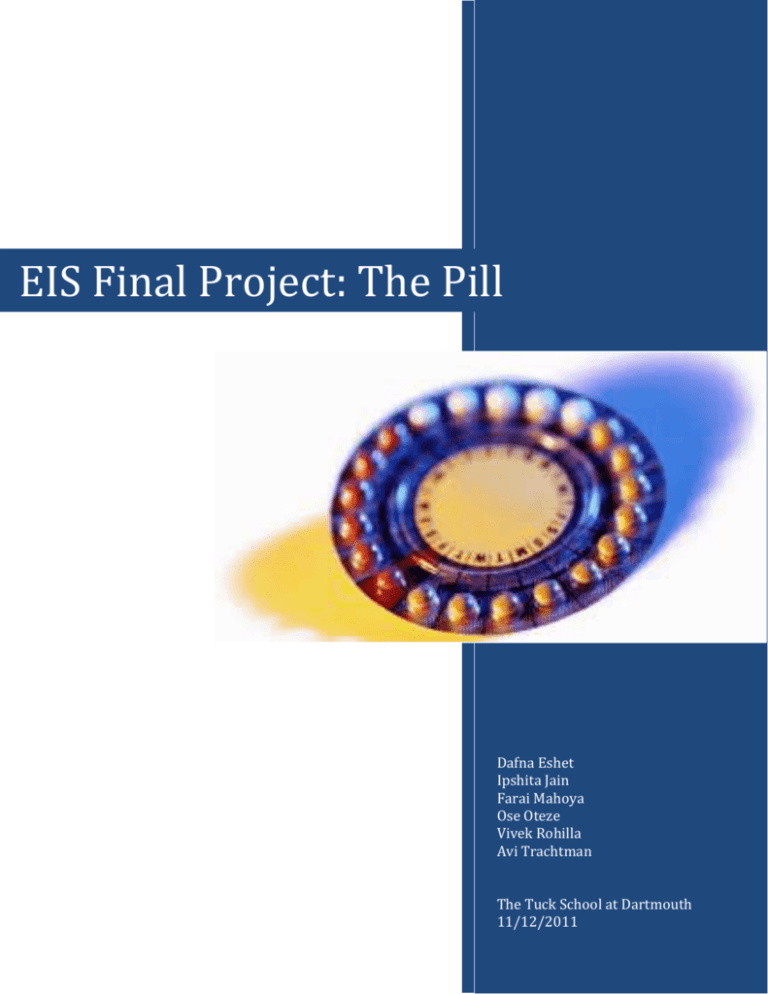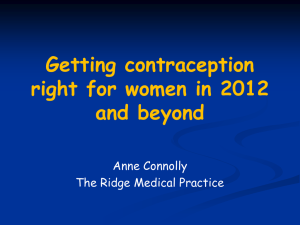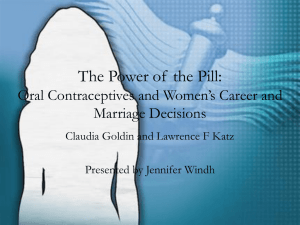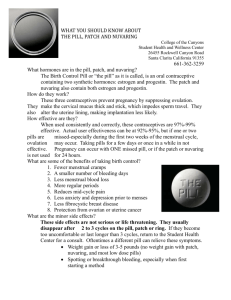EIS Final Project: The Pill
advertisement

EIS Final Project: The Pill Dafna Eshet Ipshita Jain Farai Mahoya Ose Oteze Vivek Rohilla Avi Trachtman The Tuck School at Dartmouth 11/12/2011 Introduction Sex, pregnancy and contraception have been controversial topics for millennia. It wasn't until the introduction of Enovid, the first oral contraceptive or “the Pill”, that women were finally able to control these elements. In this paper, we investigate how the introduction of the Pill changed the birth control industry, shaped a new market and how the innovation ecosystem evolved over time. Evolution of birth control before the Pill Before the development of the Pill, women all over the world used a variety of birth control methods, most of which were highly ineffective or even dangerous. The oldest known form of birth control, with origins in the Bible, is coitus interruptus – otherwise known as the withdrawal method. The ancient Greeks were the first to document use of various concoctions consisting of cedar oil and lead ointment as spermicides. In the 1700’s, Giovanni Giacomo Casanova experimented with various forms of birth control, including use of lemon rinds as primitive diaphragms/cervical caps. Such was the antiquated nature or early forms of birth control. In pre-industrial America, women used homemade herbal douches to prevent pregnancy. Some remedies required women to inject a water-based solution consisting of salt, vinegar, liquid chloride, zinc sulfite or aluminum potassium sulfite into their cervix after intercourse. The biggest innovation in the contraceptive market till that point was the invention of galvanized rubber by Charles Goodyear in 1839. Goodyear proceeded to use his technology in the manufacturing of rubber condoms as well as intrauterine devices, douching syringes, and diaphragms. The intrauterine devices, douching syringes, and diaphragms were not convenient for women’s use, nor were they extremely effective. Furthermore, use of condoms, by far the least invasive method, was completely out of women’s control. Consequently, the Pill fulfilled a crucial need at the time of its introduction for an effective and convenient contraceptive that women had complete Page | 1 control over. The Pill could be taken anytime, anywhere and without anyone else knowing. No method in previous centuries had ever achieved that level of privacy and female control. The creation and technological advancement of the Pill After several years of lobbying for women’s reproductive rights, Margaret Sanger, a women’s rights activist and founder of Planned Parenthood, approached Gregory Pincus in April 1950 and pleaded with him to develop a discrete oral contraceptive. Pincus, an American physician and biologist, had been researching hormones, in particular the hormone progesterone, which he believed could inhibit ovulation and prevent pregnancy. Sanger secured a small grant out of Planned Parenthood funds to help Pincus start his research into what would become the Pill. Pincus’s research soon confirmed that progesterone prevented ovulation in rabbits and rats. However, his request for additional funding from Planned Parenthood was denied due to the risky nature of the project. The research project thus came to a standstill in 1952 due to a lack of funds. The following year, Sanger introduced Pincus to Katharine McCormick, his second investor. McCormick, an avid feminist who had feared having children in case they inherited her husband’s schizophrenia, gave Pincus a $40,000 check and the promise of additional funding as needed. In 1954, Pincus joined forces with Dr. John Rock, a renowned Obstetrician/Gynecologist and devout Catholic, to initiate clinical trials in Boston as a step towards FDA approval. The clinical trials proved to be successful, as ovulation was prevented in 100% of the women. McCormick, who had been financing Pincus throughout his research, funded the clinical trials. In total, she invested more than $2 million in the research and development of the Pill. On a number of occasions, starting in 1950, Gregory Pincus approached a relatively small pharmaceutical company, G.D. Searle, requesting funding for the research and development of the Pill. Pincus’s requests for funding were refused because of the perceived risk associated with the R&D of such a controversial drug. Not only was the marketing of contraceptives illegal in 30 states, but the fear of a boycott by the Catholic Church led Page | 2 pharmaceutical companies to steer clear of the project. In 1970, Searle’s medical director reflected: “No major pharmaceutical manufacturer had ever dared to put its name on a “contraceptive”. The individual reaction of a very large religious minority in the United States could not be gauged. The possibility of losing overnight one fourth of all of our personnel, a considerable portion of our hospital business and a crippling number of the physician prescribers of our products was not to be dismissed lightly…”1 After the success of the “Boston Trials” Searle decided to support the R&D project by supplying Pincus and Rock with the necessary pills for a large-scale trial in Puerto Rico. In 1957, the FDA approved the use of Searle’s Enovid as a treatment for “menstrual disorders”. In the following three years, an “epidemic” of menstrual disorders swept through the US, with about 500,000 women requesting Enovid as a treatment. Searle’s annual revenues from Enovid soared to $37 million, leading the company to push for FDA approval of Enovid as a contraceptive. Finally, the FDA approved Enovid as a prescription oral contraceptive in 1960. By 1961, the number of women on the Pill had increased to 2.3 million. However it wasn’t until Griswold v. Connecticut (1965) that contraceptives were legally available to married women and until Eisenstadt v. Baird (1972) that unmarried women in all US states were allowed free access to contraceptives. 2 Margaret Sanger, the phenomenal leader that brought together the critical partnership of scientists, donors, and a pharmaceutical company, had finally achieved her goal of an effective birth control method for women. 1 Tone, Andrea. 2001. Devices and desires: a history of contraceptives in America. New York: Hill and Wang. p.227. Retrieved October 28, 2011 from: <http://books.google.com> 2 Tone. 2001. Page | 3 The Pill’s value proposition The Pill held various promises for its consumers.3 Reliability Enovid’s major differentiators (when compared to other existing forms of birth control at the time) were its reliability and effectiveness in preventing pregnancy. Earlier methods of contraception were neither safe nor reliable. The Pill promised to deliver on both qualities to women (it was considered safe when first introduced to the market); they could depend on it to be 99% effective in preventing pregnancy when taken correctly. Female control over contraception The Pill shifted contraceptive decision making into the hands of the female, unlike almost all existing forms of birth control which were controlled by the male, such as the condom and “withdrawal” method. The innovation of the Pill was therefore hailed by many women as an "equalizer" that had given them the same sexual freedom as men had traditionally enjoyed. Convenience A major reason for the low adoption rates of the diaphragm was the high level of involvement of the doctor in order to insert it. The diaphragm was an expensive birth control method and in addition, most women felt uncomfortable approaching their doctors on the topic of contraception, or having a doctor insert their diaphragm. Although the condom provided a means to bypass the doctor, it required an interruption of the sexual act, and was controlled by the man. The Pill thus provided women with a discrete form of contraception that did not constrain their daily routines; disrupt the sexual act; and did not require them to open their legs for their doctors. 3 For a comparison of birth control methods available prior to 1960, please see Table 1 Page | 4 “Natural qualities” of the Pill Dr. John Rock spent the last years of his career in a battle for the acknowledgement of the Pill as an acceptable contraceptive by the Catholic Church. Although the pill negated the need to have a menstrual period, it was designed to allow for menstruation in order to create the perception of being natural, and not inhibiting the female cycle. Since progesterone and estrogen were not artificial to the human body, it provided women, but more specifically, Catholic women with a reliable contraceptive that they could personally reconcile with their religion, regardless of the Catholic Church’s stand. Menstrual disorder treatment The original use of the drug, although not its primary use, was as a means to treat menstrual disorder. The initial approval from the FDA was for menstrual disorder treatment. While Searle and the drug developers intended for the drug to eventually serve its main purpose as a contraceptive, they realized that it would be easier to first gain approval for it as a menstrual disorder treatment, which it did effectively. The Value Partners i. Women of childbearing age Statistics from surveys show that between 36% and 39% of women who came of age in the 1910’s and 1920’s had sex before they were married. However, as contraception was not yet widely accepted by society, many women used other methods of preventing pregnancy that were either ineffective or dangerous (e.g. between the 1930’s and the 1960’s, Lysol disinfectant was commonly used as a post-coital vaginal douche and is said to have been the most popular form of birth control). Women who had unwanted pregnancies may have also gone through illegal abortions, which were sometimes fatal for the mother. Further, at the turn of the century the American economy started to experience more laborforce participation by women. In addition to the fact that women’s entry into the workforce put them into daily contact with men, thus presenting more opportunities for Page | 5 them to enter into relationships, their desire to actively participate in the workforce also meant that they wanted to have control over when and how often they were having children. ii. Doctors (integrators in the eco-system) When Margaret Sanger realized that her efforts alone would not yield the results that she was looking for, she decided to get the doctors on-board and started lobbying in support of the “doctors only” bill that would limit the dissemination of birth control information and devices to doctors only, in return for political support for her birth control agenda. This appealed to the doctors immensely, not only as a source for additional revenue, but also because it essentially gave them medical monopoly over contraception. In addition to political support, the medical profession, in particular the doctors themselves, had a lot of credibility (compared to mid-wives, for example) hence they were a very useful tool in trying to gain support of birth control with the general public as well as government agencies. For a long time, doctors were making significant amounts of money prescribing birth control products such as diaphragms. Birth control became more and more profitable for all parties involved as it was becoming popular. Given how lucrative this business was, doctors’ interests were to maintain the public’s perception of them as the experts in birth control and to retain their roles as the primary providers for birth control medical care. iii. The FDA Regulatory agencies such as the Food and Drug Administration gained authority during the World War II as the government was trying to bolster its efforts to prevent or treat venereal diseases amongst servicemen. In the years following the war, greater emphasis was placed on regulation of birth control and making information about contraceptives available to couples that wanted to explore their options. The FDA thus had a say on how information about contraception was circulated which had the potential to significantly impact how successful a form of contraception could become. Page | 6 iv. Activist groups (both proponents for and adversaries against birth control) There were many adversaries against birth control such as the Catholic Church and religious fanatics who believed that birth control and premarital sex were sinful. Groups of pro-birth-control activists were women lobbying to have more active roles in the economy, and groups looking to use birth control as a way to end poverty in the third world. The FDA was pressured in 1957 to approve the Pill, largely due to these activists. v. Political parties Contraceptives were banned by the U.S. Federal Law via the Comstock Act of 1873 which remained in existence, though in weakened form, through 1965. The Act banned pornography but also made illegal all contraceptive methods, educational materials such as descriptions of contraceptive methods and other reproductive health-related materials. The courts and political parties had the power to overturn these laws as they did in 1936 by declaring certain parts of the act, i.e. the ban on contraception, to be unconstitutional. However, some portions of it remained enforceable even when Enovid was brought to market in 1960. Politicians and government officials continued to distance themselves from the birth control discussion, with President Dwight Eisenhower stating that birth control is “not our business” and “is not a proper political or government activity or function or responsibility” in a press conference in 1959. vi. The American Medical Association The American Medical Association (AMA) is the largest association of medical doctors and medical students in the United States. The AMA was instrumental in bringing other forms of contraception such as the diaphragm into mainstream medical practice. In 1937, the AMA officially recognized birth control as an integral part of medicine which added credibility to the practice of birth control medicine. Page | 7 The Pill’s leadership prism at time of introduction to the market Value Partners Benefits Women - Doctors - - FDA - Pro activist groups Catholic Church Avoid unwanted pregnancies Workforce participation Sexual freedom Continue as experts in birth control medicine As popularity increases, contraception becomes more widely acceptable, increasing patient base Convenient to prescribe, compared to having to install diaphragms, which doctor’s considered beneath their profession Greater control over potential crises associated with illegal contraception industry Fighting world poverty - Women’s freedom of choice with birth control - Widespread use of oral contraception - N/A Political parties - Working women promoted industrialization - Political support and loyalty from large population of women AMA - Lower incidence of illegal activity once birth control is regulated - Safer medical practices Costs Surplus (+) / Deficit (-) - Stigma attached to premarital sex - Side effects may be severe - Cheaper than diaphragm, thus lower profits per patient. However, diaphragm enjoyed only low adoption rates - Easy to administer, thus may result in less patient visits over the longer term + - Loss of credibility associated with approval of dangerous drugs - Complications arising from off-label use of the Pill - N/A +/- - Resolutely opposed to artificial birth control - Sees premarital sex as sinful - Political pressure from religious groups - Moral dilemma between religion and social responsibility and entitlements - Moral dilemma between religion and social responsibility and entitlements - + + +/- + Page | 8 At its introduction, the Pill’s benefits outweighed the costs for most of the parties involved, except for the Catholic Church which turned out to be not as significant as initially thought in taking the Pill to the market. Searle’s uncertainties in the birth control market In the years following the distribution of the Pill, Searle increased their sales by 27% annually. Enovid was in fact, the first non-essential drug to become a blockbuster. However, they had gone into the market with some uncertainties with regards to their value partners, all of which they perceived as necessary for success. Loss of FDA approval due to side effect profile Enovid, although effective, had side-effects that had not been thoroughly investigated. These side effects, caused by a ten times higher than needed dosage of synthetic progesterone, included life-threatening blood clots. Given the FDA’s increasingly important role in drug success, Searle dealt with the adoption risk by staggering the end use of Enovid, but also had to be conscious of this player even after Enovid was brought to market. Competitive pressures At the same time that Enovid was gaining traction in the market, competitors were launching their first oral birth control such as Ortho-Novum made by a Johnson and Johnson subsidiary in 1963 and Norlestrin made by Parke-Davis also in 1963. Building the ecosystem Market entry Searle took cautionary measures in product development and in the way they marketed Enovid, in hopes of avoiding unnecessary controversy with the introduction of Enovid to the market. The company adapted its strategy based on perceived threats from the Catholic community, government and law enforcement officials, and the FDA. Page | 9 Introduction as treatment for menstrual ailments Searle first sought FDA approval of Enovid as a treatment for menstrual ailments. This allowed Searle to decrease any controversy from the entrance of the product to the market, assess the potential backlash from opposing parties including the religious Catholic community. “Natural” remedy The process by which Enovid worked could theoretically allow women to avoid menstruation for extended periods of time. However, Rock and Pincus wanted the Pill to be perceived as a natural process both in the eyes of women and in the eyes of the Church. Furthermore, Rock was hard set on convincing the Catholic Church that the Pill should not fall under the Vatican’s opposition to contraceptives. Therefore, Enovid was originally packaged with 21 active pills, thus allowing for menstruation and maintaining the perception of a natural menstrual cycle. Marketing as a contraceptive Enovid was originally marketed to married women only. Searle was faced with stringent laws surrounding the distribution of contraceptives to women and uncertainty regarding the Catholic community’s response to the Pill. Thus, the company decided to forfeit potential sales from single women in order to avoid association of the Pill with promiscuity and possible criminal charges. An Enovid sales print advertisement (Exhibit 1) focused on key words Family, Planning and Your, i.e. your marital partner. The advertisement publicly promoted Enovid as a decision that should be made jointly by a married couple. Aligning the ecosystem When discussing alignments, the most crucial fact to remember is that Searle needed first and foremost to ensure adoption from the law and from society. There were no immediate risks such as co-innovation (except, of course, other companies that were developing the Page | 10 exact same thing – the Pill). Despite the existence of the condom and other contraceptives, no real market substitute for providing an answer to the needs Enovid was addressing. The FDA – The approval of the Pill by the FDA came in two stages. The first application for approval of Enovid came in 1957. However, this application was sought out, not for Enovid’s contraceptive qualities but rather as a treatment for menstrual irregularities and for the treatment of infertility. Although the FDA was a “gate-keeper” in bringing Enovid to the market, we did not consider them to be the key player in the ecosystem, rather as an adopter as their approval of Enovid was not what ultimately dictated the drug’s success or failure. The approval of the drug by the FDA, many experts claimed later, might have been premature and was attributed to the FDA’s desire to approve the drug as fast as they could, without necessarily conducting the appropriate tests. The main reason for this was international pressure for population control. One researcher, Linda Grant, claimed that the Pill is “the poorest-conducted, most cursory trials of any pharmaceutical ever licensed by the FDA”. This fact, later on, resulted in the somewhat bleak outcome for Searle and Enovid in later years. The law – While approved by the FDA, the pill had one other major obstacle it had to overcome: Federal and State laws. In 1965, the US Supreme Court finally struck down the Comstock laws regarding the illegality of contraception. Using contraceptives was illegal in over half of the American states by the end of the 1950’s. However, these states rapidly changed their opinions, and one by one, legalized the use of contraceptives. This was done via lobbying but even more-so by the widespread and rapid use of the Pill. The church – John Rock and Searle initially thought that the Church’s consent would be crucial for the Pill’s success. Efforts to convince the Church to give their blessing to the Pill had been fruitless in the 1950’s. In 1951, the Pope announced that the Church would sanction the use of the rhythm method as a natural form of birth control but was resolutely opposed to the distribution of the Pill. However, history has proved that women, including Catholic women, used the Pill regardless of their faith. This misconception of the church’s importance in the eco-system, just like the premature approval of the pill, sets yet another example for the lack of a concise penetration strategy by Searle. A more concise entrance Page | 11 strategy would have never attempted the inevitably futile efforts to convince the church, especially when this was not needed at all. After all, the fact is that not only did the vast majority of catholic women in the states use the pill by the end of the decade, but also that the vast majority of catholic physicians issued it. Culture and women’s liberalization – Perhaps one of the most important alignments for Searle was not with a certain party of company, but with the era. In 1953, the Kinsey reports were published, providing statistical evidence of human sexuality. Already then, half the women in the reports attested for having sex before marriage. Women’s desire to join the workforce has also been displayed throughout the 50’s, and enabled to a large extent thanks to the pill. In many ways, The Pill supported the upsurge of women liberalization, a movement that was not caused by the Pill, but simply was helped by it. However, we do acknowledge that the Pill not only supported women’s liberalization but also contributed to the enhancement of the movement. Yet another social factor that helped in promoting the Pill, and at the very least contributed to the poor examinations done in regards to the Pill, by the FDA, was the western world movement to control the world’s population. This was a school of thought which was predominant for various reasons in the western world post WW2, and laid its own foundations for many of the reasons that led contraceptives to be so popular throughout the 1960’s. On the other hand, Searle did act in a world on a brink of change between conservatism and liberalization, and this was important on several accounts. The necessary change in the law that was required for the Pill to succeed. The alignment with the Church on one hand as the conservative delegate, and with women movements on the other, as the liberal movement delegate, and of course – with the FDA, without which, no drug can be produced or distributed. Women of childbearing age – For women however, Enovid was more than just a menstrual regulator. Many women understood the contraceptive qualities of the pill before it was marketed or approved as such. More than 500,000 women were using the pill by 1959, a Page | 12 year before the pill was approved for contraception. Needless to say, many of them probably used it as a contraceptive. This constituted as a soft entrance for the pill into the contraception industry. In 1960, the pill was approved by the FDA as a contraceptive, first in its 10 milligram dose, and later in the 5.0 milligram and 2.5 milligram doses as well. Physicians – The key players in the ecosystem, however, were the doctors, as they controlled access to the end users and were a trusted source of information. Sanger had lobbied successfully to get doctors on her side by having the law mandate them as the sole prescribers of birth control medications or devices. Shortly after Enovid was on the market as a menstrual disorder treatment, doctors made over 500,000 prescriptions. The Pill’s market had reached its critical mass! The evolution of the ecosystem Side-effects – in 1961, the American public started questioning the safety of drugs as the result of the Thalidomide Tragedy, a drug distributed in Europe which caused sicknesses and birth defects. This proved to be disastrous for Searle as rumors and later evidence of Enovid causing various side effects, including heart attacks and blood clots (due to the enhanced dosage), started appearing which in effect, handed the first mover advantage to Searle’s “safer” and less scandalous competitors. Physicians – Searle used both a push as well as a pull mechanism to get doctors on board. On the one hand, they promoted the Pill to physicians, starting at 1957 when the firm sent letters to leading physicians regarding the Pill. On the other, due to positive publicity of the Pill in popular magazines, women were seeking it out themselves. The pill as a product was unique in that it gave a perfect answer to a pressing need. Therefore, the concept needed little or no marketing. Rather, Searle should have put their efforts in marketing their brand name, and not the concept, or alternatively created high switching costs for the physicians (e.g. long term contracts with hospitals) which would have probably resulted in much improved market shares during the second half of the 1960’s when so many other companies offered their own oral contraceptives. Page | 13 By 1965, 95% of all physicians in the US administered an oral contraceptive. However, unlike any drug before, the main reason for the expansion of contraceptives was derived by demand, when more often than not, patients were proactively asking for the Pill. Competitors – as stated earlier, Searle’s mistakes enabled competitors to enter the market and eventually dominate it. Syntex which was the second runner during the 1950’s to Searle’s efforts in producing the Pill started distributing their own version, Ortho Novum in 1962 and soon became the market leaders. In fact, 13 major drug companies developed their own version of the Pill in the years to come, and towards the second half of the decade, Searle indeed lost its leading position. Searle is a great example of the first mover’s disadvantage. Despite several other companies, including Pfizer and Syntex having the ability to product the Pill by the end of the 1950’s, Searle was the only firm that actually went on and executed this bold move. However, marketing mistakes and circumstances which were rather too favorable (thus approving doses much larger than actually needed) hurt the firm in the long run. Expectations vs. Results Sanger and McCormick, avid feminists and the first investors in the Pill, had high expectations for it. However, their expectations were limited towards the social value to be derived from the Pill rather than any expectations of the size of potential profits. Consequently, they would have seen the impact of the Enovid pill today as a huge success. Searle, first approached by Pincus in the early 1950’s, was unsure of the potential market value of an oral contraceptive. To Searle executives, the notion that healthy women would be willing to take medication on a daily basis, simply to avoid pregnancy, was implausible4. Thus they seriously underestimated the market potential of the Pill. It wasn’t until the success of the “Boston Trials” that Searle decided to support the R&D project in a low-key capacity, by offering Pincus and Rock the necessary supply of pills for a large-scale trial in Puerto Rico. Searle’s president instructed Pincus to advertise his success but to “avoid our 4 The Pill. Retrieved October 28, 2011 from: <http://www.pbs.org/wgbh/amex/pill/peopleevents/e_searle.html> Page | 14 being associated, even by implication”5. Searle acted behind the scenes to promote press and articles about the new innovation into mainstream media including Time, Fortune, Ladies Home Journal and Vogue6. Thus, Searle had the opportunity to gauge the potential backlash from the public, as well as the government, with limited risk. By the late 1950’s, as Searle saw sales of Enovid soar as a treatment for menstrual problems, the company started to mobilize towards sale of The Pill as a contraceptive. Searle’s personnel continued to evaluate the potential threat to other parts of the company’s business. After learning that the perceived threats had been over estimated, the company continued to publicly push towards FDA approval of Enovid as a contraceptive. Searle’s gamble paid off; the company had a monopoly on sales of oral contraceptives for two years. By 1962, the year the second oral contraceptive was introduced to the market, 1.2 million American women were taking daily doses of The Pill; this number nearly doubled by the next year. Adoption of oral contraceptives in the US 6.5 million daily users, by 1965 5 Tone. 2001. Spar, Debora L. and Huntsberger, Briana (2005). The Business of Birth Control. Harvard Health Policy Review Vol. 6, No. 1, Spring 2005. pp. 6-17. 6 Page | 15 Hence, considering Searle’s early expectations for the introduction of Enovid, the product was a great success. Enovid turned out to be Searle's bestselling product for years, with sales peaking at $89 million in 1965 and net profits reaching $25 million every year between 1964 and 1969.7 And yet, Searle had only invested a fraction of the profits into further R&D spending. Finally, Searle didn’t suffer the consequences of a ban by the Catholic Church, nor were its executives jailed for the violation of statutes that prohibited contraceptive use.8 Searle won its public relations battle by helping create demand pull for their product. What they did right Based the huge success of oral contraceptives, and the advances of women in the workforce, Searle definitely took the right step by entering this market. They were very strategic in using a soft entry by starting in the menstrual regulation field, and then moving mainstream. This move gave them the momentum with the doctors, their initial target key players they needed to go forward. Searle was quick to notice a shift in power of their ecosystem, as women became the primary drivers of success for Enovid, requesting it from their doctors for its contraceptive “side effects” before it was approved. They were able to use this momentum to push the other adopters into accepting Enovid as a contraceptive by marketing to this new key player in the system, the women. Enovid was the first pill approved for regular use by a healthy person. This meant that women did not have to be ill to go to their doctors, and Enovid did a great job of targeting the industrial-age women through media outlets and marketing advertisements. 7 Gibbs, Nancy (2010) The Pill at 50: Sex, Freedom and Paradox. Retrieved October 28, 2011 from: http://www.time.com/time/magazine/article/0,9171,1983884,00.html Page | 16 As the market became more cutthroat with competitors diving in, Searle sought an escape strategy, by trying to market Enovid as a cure for acne in 1965, at the peak of their sales. Had this been successful, Enovid would have opened up the market considerably, to include men. Searle was unfortunately hampered in this attempt by the FDA, due to several mistakes that will be addressed next. Mistakes along the way Today, The Pill is the most widely adopted female birth control method in the United States. G.D. Searle missed a huge opportunity to have maintained a dominant share of this market. Instead, Enovid is today an obsolete birth control pill, with Searle now a part of Monsanto, due to a 1985 acquisition that diverted its focus to agricultural products. There are several contributing factors to Enovid’s demise in the birth control market. These are: First Mover Disadvantage Despite having a monopoly on the birth control market in the early sixties, this success came at a high cost. As the first company to produce such a highly controversial product, Searle spent a lot of resources building credibility and attracting adopters such as the Catholic Church, the FDA, and the state and federal legislators. All this was front-line battle was being fought while competitors focused on differentiating their products from Searle’s. A large, inefficiently sized market like the United States meant that eventually, they would have to compete on quality of their products. However, they were not prepared for that either, due to their preoccupation with the attacks on the side-effects of their pill. The additional negative attention being drawn to Enovid’s harmful side effects did not ease the burden, with John Rock and other top scientists spending valuable time conducting studies and disputing claims, instead of focusing on how to improve the drug. By the time Searle came out with a lower dose of Enovid that had less harmful side-effects, competitors were already in the market claiming to have those same benefits over Enovid’s original Page | 17 product9. Enovid was suddenly faced with a tarnished brand due to the high number of reported blood clots and damaging side effects it produced in its early adopters, and on the other side, growing competition for lower dosage varieties. Lack of Commitment from executive team: Product Innovation The highly controversial nature of The Pill during the late 1950’s made Searle itself resist the innovation, refusing to fund it. This set a precedent for the lifetime of Enovid, with limited effort on the part of the executive to dedicate resources to this pursuit. With increasing negative publicity on the harmful side effects of the high-dose Enovid, Searle was even more reluctant to put its company’s name behind this product, and only remained in the birth control market due to the lucrative returns of The Pill. By the time lower dose varieties of Enovid were proposed by John Rock, Searle faced an obstacle with the FDA, which required that the lower doses be tested as rigorously as the original product. This happened in parallel with other competitors that had learned from Searle’s mistakes and could get to market with their lower doses and competitive prices. In order to combat Enovid’s tarnished brand, Searle created a new product line, called Ovulin. This product line was unsuccessful in getting FDA approval, at a crucial time when they were losing market share to rising competitors in 1965. By the time they focused on creating a new product line that was not associated with Enovid, it was too late. Lack of Commitment from executive team: Process Innovation In the meantime, while Searle enjoyed a large share of the market during the early 1960’s the company failed to keep up with its customers, and any inconveniences they might have faced with The Pill. Enovid’s 100% success rate heavily depended on correct dosage maintained over a long-term period. Otherwise, it was just as ineffective as other birth control methods in the markets. 9 Chemical and Engineering News, Volume 42, Number 10: “Competition Sharpens in Oral Contraceptives. FDA approval of drugs from Parke Davis and Searle will increase marketing push; lower dosages will bring lower prices” http://pubs.acs.org/doi/pdf/10.1021/cen-v042n010.p023 Page | 18 When approached by a co-innovator, David Wagner, that presented a new way to ensure dosage could be accurately tracked, Searle turned it down. This innovator instead, turned to an upcoming competitor, Ortho Pharmaceutical, which then introduced its first birth control pill – Ortho-Novum, with a dial pack that clearly distinguished its pill from Enovid. Searle stubbornly continued to package its pill in a bottle that provided no way of tracking pill consumption, and eventually lost market share due to the inconvenience it presented. By the time they switched in 1964, Ortho Pharmaceuticals had already established a foothold in the market. Figure 1 below shows Searle’s (red) market share of Enovid versus competitors over time Sales Enovid = 85M Time 1965 Diversification of company strategy through acquisitions By 1965, Searle had hit its market peak and was on the verge of a decline. Earnings decreased to $23.2 million, down from $24.2 million the previous year; while industry Page | 19 competitors posted net profit increases of 19.4 percent, Searle's dropped 4.4 percent. It was under these circumstances that Daniel Searle initiated an ill-fated policy of acquisition. Purchasing a dozen small companies with a wide variety of products, including nuclear instrumentation, medical electronics, and veterinary and agricultural products, Searle diversified into unfamiliar waters instead of focusing on Enovid10. The diversification of interests due to these acquisitions led to a lack of focus on Enovid, and conflicting organizational priorities. Alternative strategies that may have provided continued market dominance First mover opportunity Searle had the opportunity, as the first mover in the industry to maintain the continued loyalty of its initial customers, by marketing its brand and working closely to understand the consumer. As we saw in the case of the “pill cam”, being first to market provides certain advantages, such as market data that could have been valuable to Searle in ensuring Enovid remained the large market dominant it started off as. Searle already had the loyalty and relationships with the key customers – women. Initiation risk sharing Searle could have partnered with other companies, instead of racing to the market, in order to ensure more people shared the risks. They could have aligned companies with the same incentives, but different markets such as partners in different geographic markets where they had no presence, in order to further improve the end product before it went out to market and got burned. Margaret Sanger’s incentive for bringing together the alliance of Pincus, McComick, Searle and Rock was for an effective female birth control, which she has successfully achieved today. Instead of only relying on her support, Searle should have recognized when to step in and become the leader in the changing ecosystem as new competitors came into the market. 10 http://www.fundinguniverse.com/company-histories/G-D-Searle-amp;-Co-Company-History.html Page | 20 Page | 21 Clear and defined strategy In order to avoid conflicting priorities within the company, Searle could have broken out Enovid’s division to better focus and align one core strategy, instead of expanding too quickly through the late 1960’s through acquisitions of companies in different industries. The Pill was never within Searle’s core strategy in the first place, with support coming from private donors instead of from within the organization. Initially Searle’s strong brand name might have proved crucial in providing credibility for the essential adopters in the ecosystem, but as the company expanded and incentives got misaligned, the birth control division should have broken up into a new organization to focus entirely on the birth control industry. Searle missed out on a great opportunity to sell its birth control division at its peak, partly due to its already tarnished reputation in the market, and its publicized struggles with the FDA on other birth control product lines. Co-innovation adoption Early adoption of co-innovations, such as the pill counter pack would also have been crucial to close process gaps and ensure weaknesses were eliminated against upcoming competition. Had Searle stayed close to its primary consumers and understood the weaknesses presented by an unreliable bottled packaging that could not be tracked, it would have not turned away the dial pack, and allowed it play into the hands of its main competitor, Ortho Pharmaceuticals. Back to basics Enovid was well known for menstrual regulation in the market, even before it became more successful as a contraceptive. Searle could have focused new product lines to target this segment of the market, voluntarily retreating from the birth control market in order to let its negative publicity boil over. They could have continued innovating on menstrual health, or found another niche market that was in line with their expertise. Instead, they spent resources on the pill for acne, which was not successful. Page | 22 Conclusion Although Searle enjoyed a short period or record revenues and profits, we do not consider Enovid to be a success story given the potential that the Pill, as an innovation, held when it first came to market. Searle had a lot of data from clinical trials that they could have leveraged and used in continued research and development but they were caught up in the day to day management of their business that the competition snuck up on them. For Searle, first mover was definitely not an advantage. Additional Resources The Pill: A Biography of the drug that changed the world, by Bernard Asbe Reputation and power: organizational image and pharmaceutical regulation at the FDA, by Daniel Carpenter The Business of Birth Control: Debora L. Spar and Briana Huntsberger Page | 23 Appendix 1: Birth Control Methods: Comparison Chart11 Method of Birth Control Efficiency in preventing pregnancy1213 Advantages Shortcomings Methods available before the advent of pill ( Pre 1960) Constant abstinence Male condom 100% - Very effective - Difficult to practice - Provides limited control to women (dependent on societal norms) 85% - Moderately effective as a birth control measure - Effective against STDs - Out of women’s control Diaphragm 84% - Moderately effective - Inconvenient - Requires frequent visits to a physician - Expensive The rhythm method 75% - Doesn’t require physician’s assistance - Natural - Requires abstinence for ~25% of a month - Relatively unreliable Spermicide 71% - Effective as secondary contraceptive - Cheap - Relatively unreliable 73% - Cheap - More effective than spermicide - Relatively unreliable - The lazy choice… - This is what you practice if you do want to get pregnant Withdrawal ("Pulling Out") Not Using Any Birth Control 15% 11 Data retrieved November 6, 2011 from http://kidshealth.org/teen/sexual_health/contraception/bc_chart.html#cat20018 12 Percentage of women not to get pregnant within a year, using each type of birth control 13 These are current statistics: we assume that efficiency rates for methods such as condoms and diaphragm were lower 50 years ago Page | 24 Appendix 2 Page | 25





